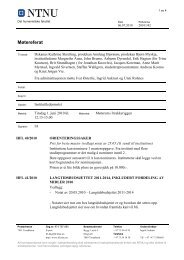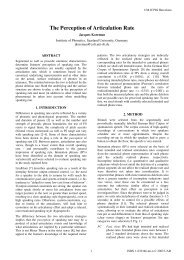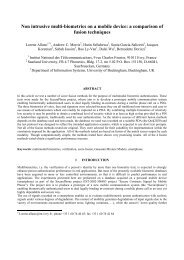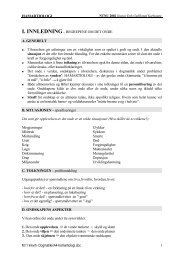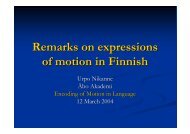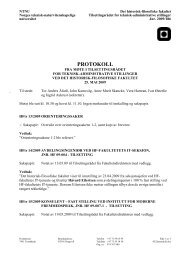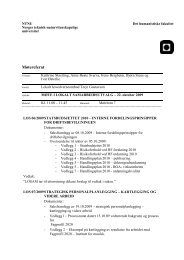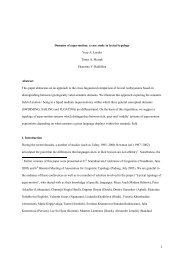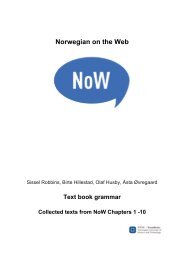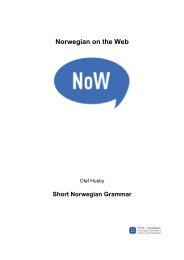In press: In: Dimitrova-Vulchanova, M - NTNU
In press: In: Dimitrova-Vulchanova, M - NTNU
In press: In: Dimitrova-Vulchanova, M - NTNU
Create successful ePaper yourself
Turn your PDF publications into a flip-book with our unique Google optimized e-Paper software.
Fig. 4 Overall frequencies of the target verbs in Bulgarian<br />
15,95<br />
14,87<br />
11,64<br />
9,48<br />
9,91<br />
8,84<br />
10,34<br />
4,53<br />
5,60<br />
5,17<br />
1,51<br />
0,86<br />
1,29<br />
vurvja hodja ticham bjagam pulzja lazja katerja se slizam general<br />
motion<br />
more<br />
specific<br />
biological<br />
motion<br />
intrinsic<br />
motion<br />
tandem<br />
motion<br />
nonmotion<br />
The histograms in Fig. 2-4 show the scoring of lexical items across all output in target<br />
scenes for each language. As expected, the cumulative percentage of target verbs across all<br />
scenes considerably exceeds the percentage of both general (non basic-level) motion verbs as<br />
well as the percentage of other (more specific) gait or path-shape verbs. Thus, there is a close<br />
match across the three languages with a total of 68,97% of target verbs for English, 73,49%<br />
for Norwegian and 68,75% for Bulgarian.<br />
A possible confound concerning this result is that basic level motion verbs are generally<br />
phonologically shorter than the more concrete (manner) verbs (cf. e.g., walk vs. meander),<br />
and subjects might have resorted to these responses for brevity. However, this is counterevidenced<br />
by our data. As a matter of fact, many responses did contain rather detailed<br />
descriptions, including prepositional phrases, manner phrases etc. An interesting observation<br />
concerns the use of general motion verbs in Norwegian at a mere 0,43%. Most likely, this<br />
result confirms our prediction that gå which covers both go and walk pre-empts the need to<br />
use other lexical items above the basic-level category. <strong>In</strong> addition, in responses for all three<br />
languages we find verbs describing not the type of motion in the scene, but rather its purpose<br />
(e.g. play, plan/intend to take a bath). This finding is highly coherent with ideas put forward<br />
in Tomasello (2001) and Zacks & Tversky (2004) that human categorization is highly<br />
susceptible to the teleology of events, and that humans attend from very early on to agents’<br />
intentions and goals. Furthermore, recent research in infant cognition based in eye-tracking<br />
20



